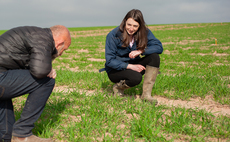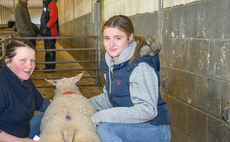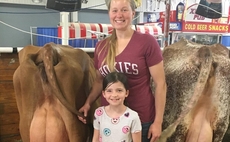
Mervyn Rowe has been driving the same combine harvester for 52 years and he is as proud now as he was when he purchased it.
Ruth Wills finds out more about the man behind the wheel and why he will never sell...
Arriving at Tregondale Farm on a beautifully hot August day in Cornwall is a scene reminiscent of the 1960s.
There are not one but two classic Claas Matador standard combines harvesting a field of spring barley and, with a friendly smile, Mervyn Rowe stops his combine and hops down to meet me.
But this 70-year-old farmer is far from a relic of the past. While he is passionate about classic combines, his farm is a truly commercial venture, with livestock and arable enterprises alongside two farm diversification ventures.
Mervyn and his family have farmed at Tregondale, near Menheniot, for 47 years, and they now run 150 sheep and 80 cows plus followers across 120 hectares (300 acres). He lives on the farm with his wife Stephanie, son Richard, daughter-in-law Helen and grandchildren Alexis, Imogen and Charisse, 15.
Standing in a field with gorgeous panoramic views, Mervyn is quick to point out the Dartmoor and Cornish landmarks of Kit Hill, Tregantle and Caradon, all of which can be seen in the distance.
He was brought up just a few miles down the road at Trewint, where his brother now farms and where in 1952, when Mervyn was just four years old, his father was one of the first in the area to own a combine - a Claas Super Junior.
Vintage
Fifteen years later, in 1967, when Mervyn was 18, he replaced it with a Matador standard for £1,800 - the same one he is driving today.
He recalls the day the combine arrived.
"The combine turned up in the yard and we were waiting for the rep to come. We were anxious to go combining - the crop was fit and everybody around me said, ‘why don't you have a go?'
"The lorry driver told me how to start it - we went up and cut three rounds of the field and the rep turned up, did a few adjustments and said, ‘you don't need me, you're doing fine'. That was 51 years ago. I've been doing it every year since and I've not missed a year," he says proudly.
Mervyn went on to go contracting for neighbours and other family - the best year being when he cut 48ha (120 acres).
He remains reluctant to let anyone else drive the combine, although his son Richard snuck in early.
"He started it when he was three years old when it was parked outside the house. I was ready to go combining and he climbed up the steps and pressed the button."
Obviously bitten by the classic bug at a young age, Richard bought another Matador standard, an older machine to be used for spares.
But they soon found there was nothing wrong with the ‘new' combine and have kept it going ever since. In the first year that Richard owned the combine he paid £600 for it with money earned from contracting.
So how have they managed to keep them going for so long?
Regular maintenance and thorough inspection when harvest is finished is key to keeping a classic combine on top form, explains Mervyn.
"It comes into the shed every night and it's only got wet once in its life - when we had a diesel problem and it broke down. It's easy to put it in the shed because it's only an 8ft cut - you can pick up and go through a 10ft gateway."
At the end of the season the combines are religiously cleaned - every grain of corn is cleaned out.
"They are oiled and greased and put away for winter."
The family has diversified over the years and in 2001, after the foot-and-mouth outbreak, they converted their old pig houses into offices - something for which there has been more demand in recent years. They also diversified into bed and breakfast - another popular revenue - in which they enjoy meeting new, interesting people.
Looking towards the future of the farm, Mervyn's grandchildren are all interested in farming. In particular, is his oldest grandchild Charisse has shown a keen interest in the arable side of the farm.
"We were lucky in 1971 to buy the farm - very fortunate. Although it's worth a lot now, it's only an accrued asset. I shall never see it cashed in because we're happy for Richard to be home here and we hope that one of his daughters will carry on the farm."
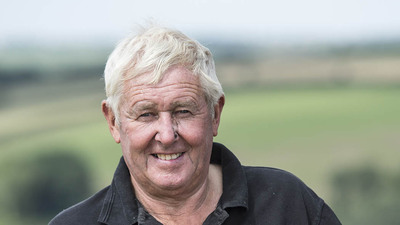
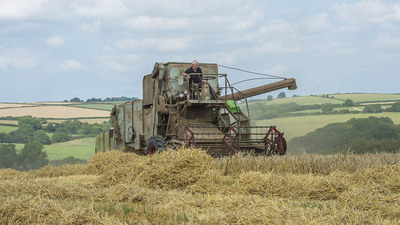
OTHER OLD FAITHFULS
1975 Clayson 1530
Martin Howlett, a beef and sheep farmer at Deer Park Farm, Callington, Cornwall, bought a 1975 combine after his previous combine broke down.
"As long as you can get the parts, why spend a lot on a new combine?"
Although he only grows 20ha (50 acres) of winter and spring barley, winter oats and spring beans on his 120ha (300-acre) farm, he makes his own rations.
"By growing just 50 acres it allows us control of our own destiny. I paid for the combine in one season's work."
In terms of maintenance Martin greases the combine parts well then stores them carefully for winter.
"Having a good supplier for genuine parts and being able to get hold of them when you need them is incredibly important.
"If we can keep it for another 10 years I'll be happy; self-sufficiency is our drive."
1982 Massey Ferguson 800
At Glen Court Farm, Llanllowell, Monmouthshire, Stuart Andrews owns a 1982 Massey Ferguson 800, which he has had for about seven years.
"The reason behind buying the combine is a funny story," he says. "My son was getting married and we had one field left to harvest which was due to be cut on his wedding day. We had arranged for someone to cut the field - he arrived, went once round the field and decided to go topping instead. The rain arrived and we lost those 10 acres of corn."
To avoid using a contractor again, Stuart went and bought the Massey Ferguson 800 from a farm sale. As he only has 20ha (50 acres) of wheat and barley to cut, the combine only works for about two weeks a year.
"It's very reliable. We do nothing more than grease it, and it started up first time when we wanted to cut our oats," he says.
"The driver, John Collingbone, is 78 years of age and he loves driving it - we can't get him off it."

















